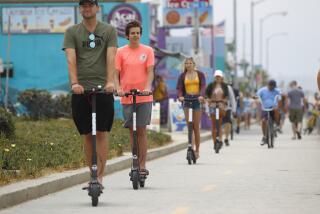Motor Scooters Put Putt-Putt in Westwood’s Travel Picture
- Share via
On a recent Monday afternoon, 20-year-old Tony LoCasio hopped on his bright red motor scooter and rode to Westwood Village to pick up hamburgers for his friends at UCLA’s Phi Kappa Psi fraternity house on Gayley Avenue.
The trip took 10 minutes. Had he taken his car, the errand would have taken considerably more time and certainly caused a lot more frustration.
LoCasio is among a growing number of Westwood residents who have found in the motor scooter a cheap, yet trendy, way of avoiding parking hassles and reducing transportation costs.
“It’s a lot more freedom and it saves a lot of gas,” said Pattie Penalosa, 18, who does errands in Westwood on a scooter she bought two months ago. “Plus, they’re trendy.”
For Short Trips
Penalosa uses her car for long distance but relies on her scooter for shorter trips.
Barbara Robbins, 29, manager of Kangaroos USA on Weyburn Avenue in Westwood, said she does most business errands on her scooter. “This gives me a 10-mile-radius of freedom that I didn’t have with the car. I can get places faster, I don’t have to worry about parking and it goes fairly fast.”
Although motor scooters have been in this country since the early 1950s, their popularity remained relatively low until two years ago when American Honda Motors Co. Inc. entered the American scooter market with its Elite, Aero and Spree models.
At about the same time, Yamaha introduced its Riva scooter into the American market.
Although Honda says its scooters will account for 90% of this year’s U.S. scooter sales, there is still a demand for the older Vespa and Lambretta models, originally imported from Italy in the early 1950s. Larry Wise, secretary-treasurer of Cosmopolitan Motors in Hatboro, Pa., which imports Lambrettas, said his company is sold all of the 1,200 Lambretta Amico scooters it had this year.
Why the Popularity?
Wise said Americans became interested in scooters because they were seen as cleaner and more convenient than motorcycles.
List prices for Honda scooters range from $398 for the Spree to $1,798 for the top-of-the-line Elite. Yamaha’s four lines of Riva scooters sell for between $659 and $1,699. The company’s two least expensive models are not available in California, however, so its lowest retail price in this state is $1,199.
Maximum speeds for the Spree and the Aero are between 30 and 39 miles per hour. The Elite 250, which has a 250-cubic-centimeter engine, can reach 70 miles and is legal for use on freeways.
With aggressive marketing by Honda and Yamaha, sales in the United States jumped from an estimated 25,000 units in 1983 to an expected 120,000 this year, an increase of 380%, according to Pamela Amette, director of research and statistics for the Motorcycle Industry Council.
‘Good Advertising’
“I attribute it (the scooter’s popularity) to good advertising and marketing,” she said. “Not much has been done to encourage new buyers to enter the (motorcycle) market. The scooter is a good vehicle for people to first come into the industry on.”
Honda last year ran two television ads--one featuring rock singers Grace Jones and Adam Ant and the other featuring the New Wave rock group Devo--aimed at young people.
“That (the rock ads) of course caused quite a stir and ultimately a lot of interest in sales,” said Neil Leventhal, Honda’s motor scooter manager. “We’re focusing the ads to much more an attitudinal profile rather than a demographic profile. We’re looking much more to youthful attitudes, to people that are not afraid of taking risks.”
No wonder, then, that scooters are proliferating in youthful Westwood Village. Purwaty (Lee) Ligioso, sales manager at Honda del Rey in Culver City, said 50% of her customers are UCLA students. Another 25%, she said, attend Loyola Marymount University.
Mopeds Slip
While the moped was the preference for young people in the late 1970s, youths today are opting for the faster and more convenient motor scooter, Amette of the Motorcycle Industry Council said. She said 400,000 mopeds were sold in this country in 1978, but the number has dwindled to an estimated 30,000 this year.
“You’re talking about a vehicle (the scooter) that can easily keep up with the traffic, whereas with the moped, there were some drawbacks because of speed,” she said.
Unlike mopeds, scooters do not rely on pedals to generate power, and gear shifting is automatic.
But not only young people are buying scooters, according to Dennis Stefani, Yamaha’s division manager of production planning and research. He said a Yamaha study of domestic scooter sales showed that the average age of buyers is between 35 and 37.
He said older people see the scooter as an alternative to heavier, more complicated motorcycles. “The imagery of the product is a lot different from the motorcycle,” Stefani said. “The scooter certainly gives you the kind of wind-in-the-face and driving experience that the motorcycle does, but it’s a little more comfortable. They’re far more practical. The orientation is less rebellious.”
More to Read
Inside the business of entertainment
The Wide Shot brings you news, analysis and insights on everything from streaming wars to production — and what it all means for the future.
You may occasionally receive promotional content from the Los Angeles Times.










